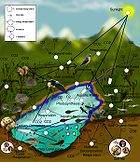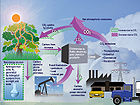- Marginal value theorem
-
In behavioral ecology, the marginal value theorem (MVT) considers an optimally foraging animal exploiting resources distributed in patches and that must decide when to leave a patch to start searching for a fresh one. The animal is assumed to have evolved to optimize a cost/benefit ratio: searching for and manipulating food is costly, while consuming food is a benefit. The decision taken by animals appears to be based on an expected transit time among patches and an observed intake rate within each patch. Examples include bees visiting flowers, birds eating berries, or even mobile phone shop owners (in which case the "resource" being exploited is paying customers).
The theorem predicts that individuals will stay longer:
- as the distance between patches increases,
- when the environment as a whole is less profitable.
The theorem states that the optimal time spent in a patch is given by the tangent to the resource intake curve that departs from the expected transit time value.
Plants have also been shown to obey the predictions of the MVT. Plant roots traveling through soil will slow their growth rate in order to remain in patches of higher soil resources for longer periods of time in exactly the same way as animals.
The MVT has been criticised on the grounds that few foragers are optimal (typical limiting factors include inability to assess exploitation rate and lack of knowledge of distant patch existence). Nevertheless, it predicts behavior that is compatible with many types of real forager behavior.
Example
A common illustration is elicited with apple picking in humans. When one first arrives at a new apple tree, the number of apples picked per minute is high but it rapidly decreases. Strategies where too few apples are picked from each tree or where each tree is exhausted are sub-optimal because they result, respectively, in time lost travelling among trees or picking the hard to find last few apples from a tree. The optimal time spent picking apples in each tree is thus a compromise between those two strategies, which is quantitatively described by the MVT.
See also
References
- Charnov, E. L. 1976. Optimal foraging: the marginal value theorem. Theoretical Population Biology 9:129–136.
- Charnov, E. L. 1976. Optimal foraging: attack strategy of a mantid. The American Naturalist 110:141–151.
- McNickle, G.G., and Cahill, J.F. Jr. 2009. Plant root growth and the marginal value theorem. Proceedings of the National Academy of Sciences USA. 106(12): 4747–4751.
Categories:- Ecological theories
- Biological theorems
Wikimedia Foundation. 2010.



